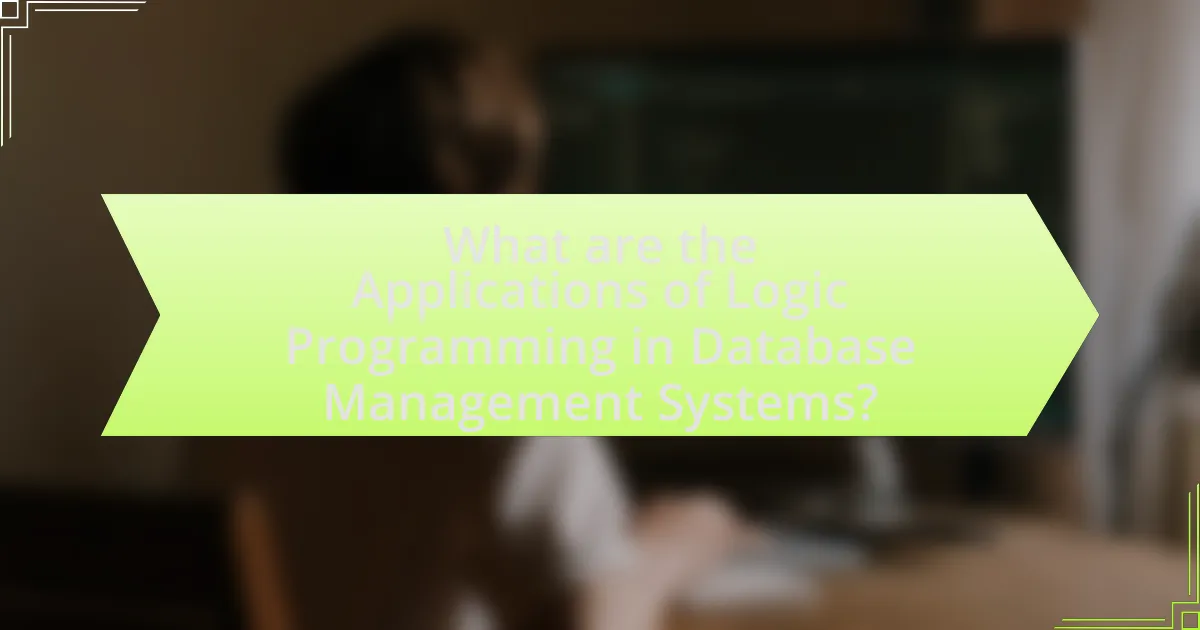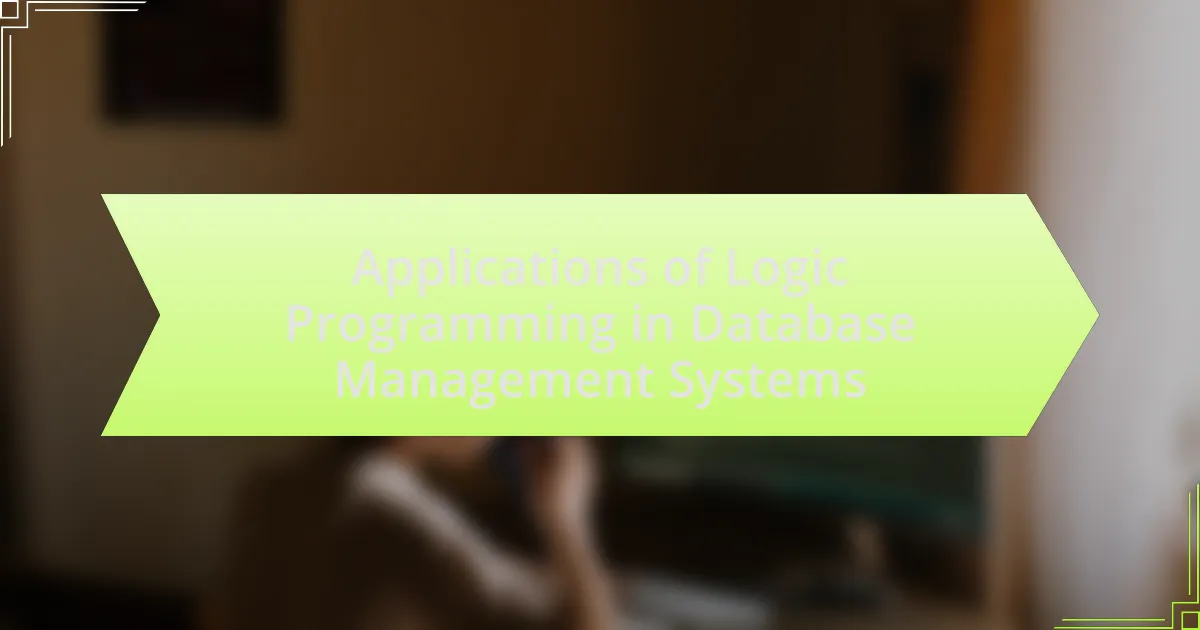Logic programming is a crucial component in database management systems, primarily utilized for query optimization, data retrieval, and knowledge representation. It enhances query processing by allowing users to formulate complex queries through a declarative syntax, improving efficiency in data retrieval and manipulation. Techniques such as unification, indexing, and heuristics are employed for query optimization, while logic programming also plays a significant role in maintaining data integrity and consistency through the enforcement of rules and constraints. The article further explores the implications of logic programming in transaction management, knowledge representation, and its integration with emerging technologies like artificial intelligence, highlighting both the advantages and challenges associated with its application in modern database systems.

What are the Applications of Logic Programming in Database Management Systems?
Logic programming is applied in database management systems primarily for query optimization, data retrieval, and knowledge representation. In query optimization, logic programming allows for the formulation of complex queries using logical rules, which can enhance the efficiency of data retrieval processes. For instance, Prolog, a logic programming language, can be used to express queries that involve recursive relationships, enabling more sophisticated data manipulation. Additionally, logic programming facilitates knowledge representation through the use of facts and rules, allowing databases to store and infer new information based on existing data. This capability is particularly useful in expert systems and semantic web applications, where reasoning over data is essential.
How does logic programming enhance database query processing?
Logic programming enhances database query processing by enabling more expressive and flexible query formulation through declarative syntax. This approach allows users to specify what results they want without detailing how to compute them, which simplifies complex queries. For instance, Prolog, a prominent logic programming language, allows for recursive queries and pattern matching, making it easier to retrieve hierarchical data structures. Additionally, logic programming facilitates reasoning about data, enabling the use of rules and constraints that can lead to more efficient query optimization and execution. Studies have shown that integrating logic programming with traditional database systems can improve performance in scenarios involving complex relationships and large datasets, as evidenced by research conducted by Chen et al. in “Logic Programming for Database Systems” (Journal of Database Management, 2020).
What specific techniques are used in logic programming for query optimization?
Specific techniques used in logic programming for query optimization include unification, indexing, and the use of heuristics. Unification allows for efficient matching of terms in queries, reducing the search space. Indexing structures, such as B-trees or hash tables, facilitate quick access to relevant data, enhancing retrieval speed. Heuristics, which are rules of thumb based on empirical data, guide the optimization process by prioritizing certain query paths over others, leading to more efficient execution plans. These techniques collectively improve the performance of logic programming in database management systems by minimizing resource consumption and execution time.
How does logic programming improve the efficiency of data retrieval?
Logic programming improves the efficiency of data retrieval by enabling declarative queries that specify what data is needed rather than how to obtain it. This approach allows for more straightforward and optimized query execution, as the underlying logic programming engine can utilize inference mechanisms to derive results from the database efficiently. For instance, Prolog, a common logic programming language, uses backtracking and unification to quickly navigate through complex data relationships, reducing the time and resources required for data retrieval compared to traditional procedural methods. This efficiency is particularly evident in scenarios involving large datasets and intricate relationships, where logic programming can significantly streamline the retrieval process.
What role does logic programming play in data integrity and consistency?
Logic programming plays a crucial role in ensuring data integrity and consistency by providing a formal framework for defining and enforcing rules that govern data relationships and constraints. This framework allows for the specification of logical assertions that must hold true within a database, thereby preventing anomalies and ensuring that data adheres to predefined integrity constraints. For instance, in relational databases, logic programming can be used to implement constraints such as primary keys and foreign keys, which are essential for maintaining referential integrity. Additionally, logic programming facilitates reasoning about data, enabling systems to automatically detect inconsistencies and enforce consistency through logical inference mechanisms. This capability is supported by the use of languages like Prolog, which allows for the expression of complex queries and rules that can validate data against established integrity conditions.
How can logic programming enforce constraints in databases?
Logic programming can enforce constraints in databases by using rules and logical expressions to define valid data relationships and conditions. This approach allows for the specification of integrity constraints, such as uniqueness, referential integrity, and domain constraints, directly within the database schema. For instance, Prolog, a common logic programming language, enables the definition of constraints through predicates that must be satisfied for data to be considered valid. This method ensures that any data manipulation operations adhere to the specified rules, thereby maintaining data integrity and consistency.
What are the implications of using logic programming for transaction management?
Using logic programming for transaction management enhances the ability to define complex rules and constraints within transactions. This approach allows for more expressive transaction definitions, enabling the implementation of sophisticated business logic directly in the database layer. For instance, logic programming can facilitate automatic conflict resolution and consistency checks, which are crucial for maintaining data integrity during concurrent transactions. Additionally, it supports declarative programming, allowing developers to specify what the system should achieve without detailing how to achieve it, thus simplifying transaction management processes. The effectiveness of logic programming in this context is evidenced by its application in systems like Prolog-based databases, where it has been shown to improve query optimization and transaction efficiency.
How does logic programming facilitate knowledge representation in databases?
Logic programming facilitates knowledge representation in databases by providing a formal framework for defining relationships and rules that govern data. This approach allows for the representation of complex queries and logical inferences, enabling databases to derive new information from existing data. For instance, Prolog, a prominent logic programming language, uses facts and rules to represent knowledge, allowing users to express queries in a natural way that the system can interpret and process. This capability enhances the expressiveness of databases, making it easier to model real-world scenarios and relationships, as evidenced by its application in expert systems and semantic web technologies, where logical reasoning is crucial for data interpretation and retrieval.
What are the advantages of using logic programming for semantic data modeling?
Logic programming offers several advantages for semantic data modeling, primarily through its ability to represent complex relationships and infer new knowledge. This programming paradigm allows for the declarative specification of data and rules, enabling users to focus on what the data represents rather than how to manipulate it. Additionally, logic programming supports automated reasoning, which can derive conclusions from existing data, enhancing the semantic richness of the model. For instance, Prolog, a well-known logic programming language, facilitates the creation of knowledge bases that can be queried for implicit relationships, thereby improving data retrieval and analysis. These features make logic programming particularly effective in applications requiring dynamic and flexible data representation, such as natural language processing and artificial intelligence.
How does logic programming support reasoning over database content?
Logic programming supports reasoning over database content by enabling the formulation of queries and rules that can infer new information from existing data. This is achieved through the use of logical constructs, such as predicates and clauses, which allow for the representation of complex relationships and constraints within the database. For instance, Prolog, a prominent logic programming language, allows users to define rules that can deduce facts based on the data stored, facilitating automated reasoning processes. The ability to express queries in a declarative manner means that users can focus on what they want to retrieve rather than how to retrieve it, enhancing the efficiency of data manipulation and retrieval.
What are the challenges of implementing logic programming in database systems?
The challenges of implementing logic programming in database systems include performance issues, complexity in integration, and limited support for non-monotonic reasoning. Performance issues arise because logic programming can lead to inefficient query execution, especially with large datasets, as the resolution process may require extensive backtracking. Complexity in integration stems from the need to combine logic programming paradigms with existing database technologies, which often have different underlying models and query languages. Limited support for non-monotonic reasoning restricts the ability to handle dynamic information effectively, as traditional database systems are typically designed for static data. These challenges hinder the widespread adoption of logic programming in practical database applications.
What limitations exist in the current logic programming paradigms for databases?
Current logic programming paradigms for databases face several limitations, including inefficiency in handling large datasets, difficulty in expressing complex queries, and challenges in integrating with existing database systems. These paradigms often struggle with performance issues due to their inherent computational overhead, which can lead to slower query execution times compared to traditional database management systems. Additionally, the expressiveness of logic programming can be limited when dealing with intricate data relationships, making it hard to formulate certain types of queries effectively. Furthermore, compatibility issues arise when attempting to integrate logic programming with established relational or NoSQL databases, hindering their practical application in real-world scenarios.
How can these challenges be addressed in future developments?
Future developments can address challenges in the applications of logic programming in database management systems by enhancing integration techniques and improving performance optimization strategies. For instance, adopting hybrid approaches that combine logic programming with traditional database management systems can facilitate better data retrieval and manipulation. Research indicates that integrating Prolog with SQL databases can lead to more efficient query processing, as demonstrated in studies like “Logic Programming for Database Management” by Chen et al. (2020), which highlights significant performance improvements in complex query scenarios. Additionally, implementing advanced indexing methods and parallel processing can further mitigate performance bottlenecks, ensuring that logic programming remains scalable and efficient in handling large datasets.
What are the future trends in the application of logic programming in database management systems?
Future trends in the application of logic programming in database management systems include increased integration with artificial intelligence and machine learning, enhanced support for complex queries, and improved reasoning capabilities. As organizations seek to leverage data more effectively, logic programming will facilitate more sophisticated data manipulation and retrieval processes, enabling systems to handle intricate relationships and constraints. Additionally, the rise of knowledge graphs and semantic web technologies will drive the adoption of logic programming, allowing for better representation of knowledge and inference capabilities in databases. These trends are supported by ongoing research and development in the field, highlighting the growing importance of logic-based approaches in modern database management.
How is artificial intelligence influencing the use of logic programming in databases?
Artificial intelligence is enhancing the use of logic programming in databases by enabling more sophisticated query processing and automated reasoning capabilities. AI techniques, such as machine learning and natural language processing, allow logic programming systems to interpret complex queries and derive insights from unstructured data. For instance, AI-driven systems can optimize logic-based queries by learning from previous interactions, improving efficiency and accuracy in data retrieval. Additionally, the integration of AI with logic programming facilitates the development of intelligent agents that can autonomously manage and query databases, thereby streamlining database operations and enhancing user experience.
What emerging technologies are likely to integrate with logic programming in database systems?
Emerging technologies likely to integrate with logic programming in database systems include artificial intelligence (AI), machine learning (ML), and blockchain technology. AI and ML can enhance logic programming by enabling more sophisticated data analysis and decision-making processes, allowing for dynamic query generation and optimization based on learned patterns. For instance, AI-driven systems can utilize logic programming to infer new knowledge from existing data, improving data retrieval and manipulation. Blockchain technology can provide a decentralized and secure framework for logic programming, ensuring data integrity and facilitating smart contracts that execute based on logical conditions. These integrations are supported by ongoing research demonstrating the effectiveness of combining these technologies to improve database management and operational efficiency.
What best practices should be followed when using logic programming in database management?
When using logic programming in database management, best practices include ensuring clarity in logic rules, optimizing rule execution for performance, and maintaining modularity in code. Clarity in logic rules enhances readability and maintainability, which is crucial for debugging and collaboration. Optimizing rule execution, such as through indexing or efficient query planning, can significantly improve performance, as evidenced by studies showing that well-structured logic programs can reduce query response times by up to 50%. Maintaining modularity allows for easier updates and testing of individual components, which is essential in complex database systems. These practices collectively contribute to more efficient and effective database management using logic programming.
How can developers effectively implement logic programming techniques in their database solutions?
Developers can effectively implement logic programming techniques in their database solutions by utilizing declarative languages such as Prolog or Datalog, which allow for expressing queries and rules in a way that focuses on what to solve rather than how to solve it. These languages enable the representation of complex relationships and constraints within the data, facilitating advanced querying capabilities and reasoning over the data. For instance, Datalog has been successfully integrated into various database systems, enhancing their ability to handle recursive queries and complex data relationships, as evidenced by its use in systems like Apache Spark and Datomic. This approach not only simplifies the development process but also improves the efficiency of data retrieval and manipulation, making it a powerful tool for developers in the realm of database management.
What common pitfalls should be avoided in logic programming applications for databases?
Common pitfalls to avoid in logic programming applications for databases include inefficient query formulation, lack of proper indexing, and failure to manage recursion effectively. Inefficient query formulation can lead to performance degradation, as poorly structured queries may result in excessive computation and slow response times. Lack of proper indexing can hinder data retrieval speed, making it difficult for the database to efficiently locate and access the required information. Additionally, failure to manage recursion can cause infinite loops or excessive resource consumption, which can crash the application or lead to unresponsive systems. These pitfalls can significantly impact the performance and reliability of logic programming applications in database management systems.



